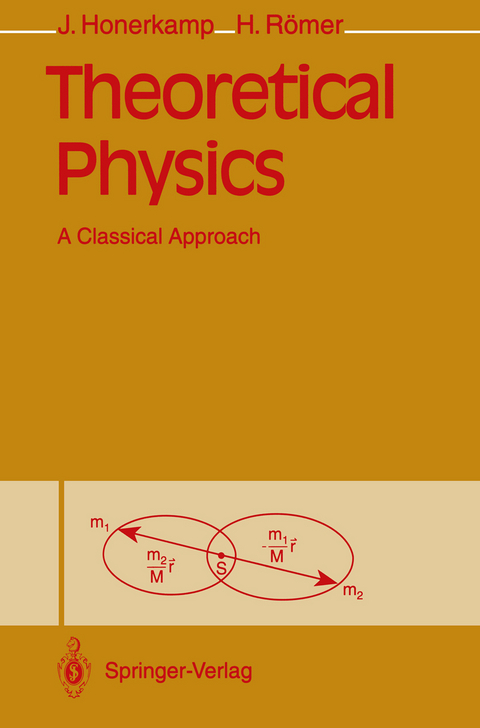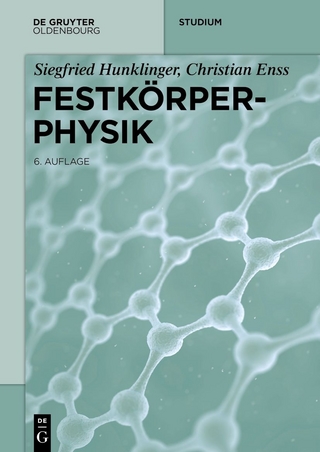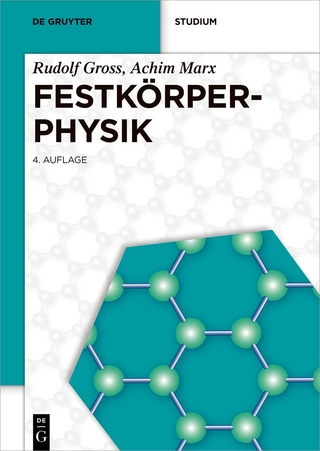
Theoretical Physics
Springer Berlin (Verlag)
978-3-642-77986-2 (ISBN)
Josef Honerkamp hat mehr als 30 Jahre als Professor für Theoretische Physik gelehrt, zunächst an der Universität Bonn, dann viele Jahre an der Universität Freiburg. Er ist Autor mehrere Lehrbücher, im Rahmen seiner Forschungstätigkeit hat er auf folgenden Gebieten gearbeitet: Quantenfeldtheorie, Statistische Mechanik, Nichtlineare Systeme und Stochastische Dynamische Systeme. Er ist Mitglied der Heidelberger Akademie der Wissenschaften.
1. Introduction.- 2. Newtonian Mechanics.- 2.1 Space and Time in Classical Mechanics.- 2.2 Newton's Laws.- 2.3 A Few Important Force Laws.- 2.4 The Energy of a Particle in a Force Field.- 2.5 Several Interacting Particles.- 2.6 Momentum and Momentum Conservation.- 2.7 Angular Momentum.- 2.8 The Two-Body Problem.- 2.9 The Kepler Problem.- 2.10 Scattering.- 2.11 The Scattering Cross-Section.- 2.12 The Virial Theorem.- 2.13 Mechanical Similarity.- 2.14 Some General Observations About the Many-Body Problem.- Problems.- 3. Lagrangian Methods in Classical Mechanics.- 3.1 A Sketch of the Problem and Its Solution in the Case of a Pendulum.- 3.2 The Lagrangian Method of the First Type.- 3.3 The Lagrangian Method of the Second Type.- 3.4 The Conservation of Energy in Motions Which are Limited by Constraints.- 3.5 Non-holonomic Constraints.- 3.6 Invariants and Conservation Laws.- 3.7 The Hamiltonian.- 3.8 The Hamiltonian Principle of Stationary Action.- Problems.- 4. Rigid Bodies.- 4.1 The Kinematics of the Rigid Body.- 4.2 The Inertia Tensor and the Kinetic Energy of a Rigid Body.- 4.3 The Angular Momentum of a Rigid Body, Euler's Equations.- 4.4 The Equations of Motion for the Eulerian Angles.- Problems.- 5. Motion in a Noninertial System of Reference.- 5.1 Fictitious Forces in Noninertial Systems.- 5.2 Foucault's Pendulum.- 6. Linear Oscillations.- 6.1 Linear Approximations About a Point of Equilibrium.- 6.2 A Few General Remarks About Linear Differential Equations.- 6.3 Homogeneous Linear Systems with One Degree of Freedom and Constant Coefficients.- 6.4 Homogeneous Linear Systems with n Degrees of Freedom and Constant Coefficients.- 6.5 The Response of Linear Systems to External Forces.- Problems.- 7. Classical Statistical Mechanics.- 7.1 Thermodynamic Systems and Distribution Functions.- 7.2 Entropy.- 7.3 Temperature, Pressure, and Chemical Potential.- 7.4 The Gibbs Equation and the Forms of Energy Exchange.- 7.5 The Canonical Ensemble and the Free Energy.- 7.6 Thermodynamic Potentials.- 7.7 Material Constants.- 7.8 Changes of State.- 7.9 The Transformation of Heat into Work, the Carnot Efficiency.- 7.10 The Laws of Thermodynamics.- 7.11 The Phenomenological Basis of Thermodynamics.- 7.12 Equilibrium and Stability Conditions.- Problems.- 8. Applications of Thermodynamics.- 8.1 Phase Transformations and Phase Diagrams.- 8.2 The Latent Heat of Phase Transitions.- 8.3 Solutions.- 8.4 Henry's Law, Osmosis.- 8.5 Phase Transitions in Solutions.- Problem.- 9. Elements of Fluid Mechanics.- 9.1 A Few Introductory Remarks About Fluid Mechanics.- 9.2 The General Balance Equation.- 9.3 Particular Balance Equations.- 9.4 Entropy Production, Generalized Forces, and Fluids.- 9.5 The Differential Equations of Fluid Mechanics.- 9.6 A Few Elementary Applications of the Navier-Stokes Equations.- Problem.- 10. The Most Important Linear Partial Differential Equations of Physics.- 10.1 General Considerations.- 10.2 Solutions of the Wave Equation.- 10.3 Boundary Value Problems.- 10.4 The Helmholtz Equation in Spherical Coordinates, Spherical Harmonics, and Bessel Functions.- Problems.- 11. Electrostatics.- 11.1 The Basic Equations of Electrostatics and Their First Consequences.- 11.2 Boundary Value Problems in Electrostatics, Green's Functions.- 11.3 The Calculation of Green's Functions, the Method of Images.- 11.4 The Calculation of Green's Functions, Expansion in Spherical Harmonics.- 11.5 Localized Charge Distributions, the Multipole Expansion.- 11.6 Electrostatic Potential Energy.- Problems.- 12. Moving Charges, Magnetostatics.- 12.1 The Biot-Savart Law, the Fundamental Equations of Magnetostatics.- 12.2 Localized Current Distributions.- 13. Time Dependent Electromagnetic Fields.- 13.1 Maxwell's Equations.- 13.2 Potentials and Gauge Transformations.- 13.3 Electromagnetic Waves in a Vacuum, the Polarization of Transverse Waves.- 13.4 Electromagnetic Waves, the Influence of Sources.- 13.5 The Energy of the Electromagnetic Field.- 13.6 The Momentum of the Electromagnetic Field.- 14. Elements of the Electrodynamics of Continuous Media.- 14.1 The Macroscopic Maxwell Equations.- 14.2 Electrostatic Fields in Continuous Media.- 14.3 Magnetostatic Fields in Continuous Media.- 14.4 Plane Waves in Matter, Wave Packets.- 14.5 Reflection and Refraction at Plane Boundary Surfaces.- Appendices.- A. The ?-Function.- B. Conic Sections.- C. Tensors.- D. Fourier Series and Fourier Integrals.- D.1 Fourier Series.- D.2 Fourier Integrals and Fourier Transforms.- E. Distributions and Green's Functions.- E.1 Distributions.- E.2 Green's Functions.- F. Vector Analysis and Curvilinear Coordinates.- F.1 Vector Fields and Scalar Fields.- F.2 Line, Surface, and Volume Integrals.- F.3 Stokes's Theorem.- F.4 Gauss's Theorem.- F.5 Applications of the Integral Theorems.- F.6 Curvilinear Coordinates.- Problems.- References.
| Erscheint lt. Verlag | 16.12.2011 |
|---|---|
| Übersetzer | H. Pollack |
| Zusatzinfo | XIV, 569 p. |
| Verlagsort | Berlin |
| Sprache | englisch |
| Maße | 155 x 235 mm |
| Gewicht | 878 g |
| Themenwelt | Naturwissenschaften ► Physik / Astronomie ► Festkörperphysik |
| Naturwissenschaften ► Physik / Astronomie ► Quantenphysik | |
| Naturwissenschaften ► Physik / Astronomie ► Theoretische Physik | |
| Technik ► Maschinenbau | |
| Schlagworte | classical mechanics • electricity • Elektrostatik • Fluid Dynamics • Klassische Mechanik • magnetism • Magnetostatik • Strömungslehre • theoretical physics • Theoretische Physik • thermodynamics • Thermodynamik |
| ISBN-10 | 3-642-77986-7 / 3642779867 |
| ISBN-13 | 978-3-642-77986-2 / 9783642779862 |
| Zustand | Neuware |
| Haben Sie eine Frage zum Produkt? |
aus dem Bereich


